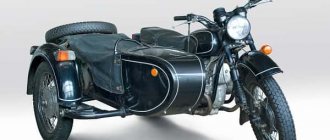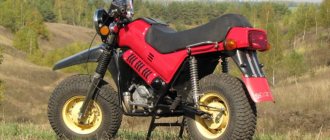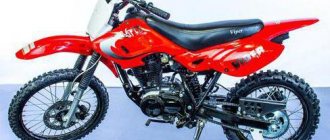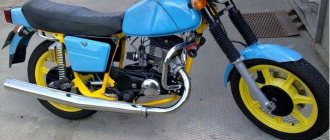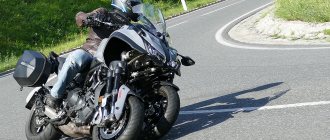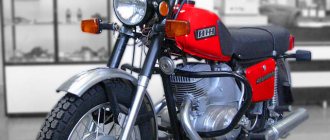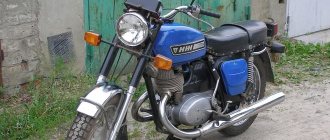RU-MOTO rating
- Reliability
- Chassis
- Appearance
- Comfort
4.5
Verdict
Looking at such motorcycles, you understand the approach with which the equipment was created. The dominant factor was the creation of a durable, workhorse, and such concepts as comfort, appearance and dynamics faded into the background. Now such an idea will not find its consumer. Therefore, the Dnieper has already become an interesting page in our history.
The Dnepr motorcycle is a child of the Kyiv motorcycle plant. Given its characteristics, there is no need to talk about a bright plastic fairing, acceleration to a hundred or noisy shots along the avenue. This is not about him, but he doesn’t need it, his path is different - he is a real hard worker.
Motorcycles of this brand appeared immediately after the war, and went through a thorny path in such difficult years for the industry. Now we are accustomed to perceiving a motorcycle as a luxury item, but back then, with a shortage of automobiles, it was an irreplaceable thing. The Dnepr could be used not just as a motorcycle with a sidecar for the family, but as a tractor and a truck, carrying the difficult life of a Soviet person on its shoulders.
Dnepr M-72 prototype - German BMW R-71
It is also interesting that the first-born in the line - the M-72 motorcycle - became the Soviet incarnation of the German representative BMW R-71.
The lineup then looked like this:
- 1952 - model M72;
Dnepr M-72
- 1958 - model K750;
Motorcycle Dnepr K-750
- 1963 - model K750M;
Motorcycle Dnepr K-750M
Read other motorcycle reviews of HONDA CBR1100XX – a fast motorcycle for brave people
- 1968 - model K650 “Dnepr” (MT-8);
Motorcycle Dnepr K-650
- 1971 - model MT-9;
Motorcycle Dnepr MT-9
- 1974 - model MT-10;
Motorcycle Dnepr MT-10
- 1976 - model MT-10-36;
- 1978 - model MT-12;
Motorcycle Dnepr MT-12
- 1985 - model MT-11;
Motorcycle Dnepr MT-11
- 1986 - model MT-16;
Motorcycle Dnepr MT-16
- 1991 - model Dnepr KMZ 8.157.01 “Solo”;
Motorcycle Dnepr KMZ 8.157.01 “Solo”
Read other motorcycle reviews Review of the Minsk D4 125 motorcycle
- 1991 - model Dnepr KMZ 8.157.02.
Motorcycle Dnepr KMZ 8.157.02
There were other models, but they were less common and highly specialized. And as an example for study, we decided to take the MT-10-36 model.
Specifications
All this difficult contraption had to be driven by a boxer, four-stroke engine with a volume of 650 cm3. This motorcycle was very different from the majority of the Soviet motorcycle industry, represented by two-stroke small-capacity models. The unit produced 36 hp per 335 kg of mass and could accelerate this “tank” to 105 km/h.
Previously, the site Ru-moto.com published a review of the Voskhod 3M motorcycle
The motorcycle was air-cooled, but the arrangement of the cylinders made it possible to catch the air flow well. With this design, it was possible to adapt and dry shoes while driving (there is evidence that German soldiers used this in their BMWs).
The special feature and main advantage is the large load capacity of 260 kg (as stated by the manufacturer). Of course, few people took this into account; the motorcycle was overloaded two or even three times. However, many of these specimens are still alive and continue to work in rural areas. You can draw your own conclusions about the former power of the structure.
Equipped with a four-speed gearbox and, as befits a heavy motorcycle, one reverse gear.
Motorcycle Dnepr MT-10-36
The motorcycle frame clearly showed itself to be a durable unit. You can make sure by looking at what loads this motorcycle can transport. This strength is due to the presence of the stroller, since when constantly driving with it, the frame experiences unidirectional loads and deforms. This can be seen on lighter motorcycles with sidecars, such as Java, Izh.
The suspension of the motorcycle consisted of a telescopic fork on a hydraulic shock absorber at the front, and a pendulum on shock absorbers at the rear. Dnepr can be called quite comfortable. The cross-country ability, despite the weight and dimensions, was also satisfactory - the motorcycle had to go everywhere.
Everything regarding electrical equipment remained rather archaic; the only serious step in this model was the transition to the 12th century. The engine was started using a kickstarter.
The consumption according to the passport was 8 liters, but in reality, under harsh operating conditions, it went well beyond 10 liters, but then few people worried about it. About 19 liters fit into the tank.
| Total information | |
| Max wheelbase (length between front and rear wheel axles) | 1500 mm |
| Min clearance between the ground and the bottom of the chassis (clearance) | 125 mm |
| Max length with stroller | 2430 mm |
| Max height with stroller | 1080 mm |
| Max width with stroller | 1680 mm |
| Max dry weight: | |
| with stroller | 335 kg |
| without stroller | 220 kg |
| Max load capacity (weight of driver and two passengers) | 260 kg |
| Max speed | 105 km/h |
| Max braking distance from speed | 60 km/h 30 m |
| Max fuel consumption per 100 km | 8 l |
| Max oil consumption per 100 km | 0.15 l |
| Max noise level | 86 dB |
| Engine | |
| engine's type | four-stroke, carburetor, overhead valve, two-cylinder |
| Cylinder displacement | 649 cm3 |
| Compression ratio | 7,5 |
| Cylinder diameter | 78 mm |
| Piston stroke | 68 mm |
| Max power | 26.5 (36) kW (hp) |
| Speed corresponding to maximum power | 5600–5900 rpm |
| Max torque | 47 (4.8) N•m (kgf•m) |
| Speed corresponding to maximum torque | 4900–5200 rpm |
| Carburetor type | K301D |
| Fuel | gasoline A-76 or A-72 |
| Air purifier | combined - inertial and contact-oil |
| Cooling | air |
| Power transmission | |
| Clutch | dry, double disc; driven discs with friction material linings on both sides. The clutch release drive is double: manual - from the lever on the steering wheel; foot - interlocked with the gearbox shift mechanism |
| Transmission | four-speed, with reverse gear |
| Gear shift | foot pedal to engage four main gears; manual reverse lever |
| Gear ratios in the gearbox: | |
| 1st gear | 3,6 |
| 2nd gear | 2,28 |
| III gear | 1,7 |
| IV gear | 1,3 |
| reverse | 3,67 |
| main gear | spiral-conical |
| Final drive ratio | 4,62 |
| Chassis | |
| Frame | tubular, welded |
| Rear wheel suspension | lever on double-acting spring-hydraulic shock absorbers |
| Front fork | telescopic, with double-acting hydraulic shock absorbers |
| Wheels | interchangeable, easily removable, with cast housings, adjustable tapered roller bearings |
| Brakes | chocks, adjustable on the front and rear wheels of a motorcycle |
| Tires | 95–484 (3.75–19) mm (inches) |
| Stroller | single-seater, passenger-type body, sprung with rubber springs; wheel on a lever suspension with a spring-hydraulic shock absorber |
| Stroller frame | tubular, welded |
| Electrical equipment | |
| Accumulator battery | 3MT6 – 2 pcs. (or 6MTC9 – 1 pc.) |
| Alternator | 12 V, 150 W G424 |
| Relay regulator | PP330 |
| Ignition system | battery, 12 V with automatic ignition timing control |
| Ignition coil | B204 |
| Breaker | PM302-01 |
| Candles | A10HT or A11H |
| Sound signal | C38 |
| Speedometer | SP102 |
| Speedometer flexible shaft | GV127 |
| Brake light switch | VK854 |
| Light switch | P25-A |
| Turn signal switch | P201 |
| Turn signal relay | PC427 |
| Emergency oil pressure sensor | MM126 |
| Signal lamp | PD20E, PD20D |
| headlight | FG137 |
| Back light | FP246 |
| Sidecar rear light | FP219B |
| Stroller front light | PF232B |
| Turn signal lamp | UP223B |
| Central switch | VK857 |
| Capacities | |
| Fuel tank | 19 l |
| Crankcase | 2.2 l |
| Gearbox housing | 1.5 l |
| Final drive housing | 0.11 l |
| Front fork leg | 0.13 l |
| Shock absorber | 0.105 l |
| Basic data for adjustment and control | |
| Gap between rocker arm and valve on a cold engine (at 15–20°C) | 0.07 mm |
| Gap between breaker contacts | 0.4–0.6 mm |
| Gap between spark plug electrodes | 0.6–0.75 mm |
| Wheel tire pressure: | |
| stroller and front | 0.15–0.16 (1.5–1.6) MPa (kgf/cm2) |
| rear | 0.26–0.27 (2.6–2.7) MPa (kgf/cm2) |
| Gap between spark gap and ignition coil terminal | 8-9 mm |
Weaknesses of the Dnepr motorcycle engine
Contact ignition. Most owners indicated that there were problems with the ignition. The motor runs unevenly and is interrupted. The problem is solved by installing electronic ignition.
Checkpoint. According to some owners, the gearbox is not highly reliable, but most of the problems are associated with improper operation and untimely maintenance.
Causes and solutions to the most common faults occurring in the gearbox:
- Difficult gear shifting - often due to low oil level in the gearbox. Even a small defect can lead to gear shifting problems. Oil is responsible for lubricating all parts of the box, but it should be remembered that after some time it loses its lubricating properties. In this case, change the oil immediately.
- Grinding when shifting gears is usually the result of jamming or wear of the synchronizers - metal rings located on the main shaft of the gearbox, which are supposed to equalize the speed of rotation of the gears. It is the synchronizers that are responsible for the smooth activation of gears. Each gear has its own synchronizer.
- Noisy gearbox operation - the most common cause is worn bearings or gears. This should not be underestimated, as damage to the bearings can even lead to housing rupture.
Pistons. The weakness of the pistons is that the bottom burns out. With 5-10 minutes of engine operation with an ignition timing angle of more than 45°. When overheating, the engine begins to operate with increased noise, loss of power and does not stall when the ignition is turned off (due to overheating, glow ignition occurs). To avoid burning out the pistons, it is necessary to set the advance angle within 32-36° to the top dead center of the piston.
The most common problems with Dnepr motorcycle engines:
The engine does not start.
- The fuel supply system is clogged;
- Spark plugs have failed (carbon deposits, etc.);
- Insufficient compression in the cylinders (valve clearance, rings, etc.);
- The power supply is intermittent;
- Uneven fuel supply;
- Water in the engine or fuel;
- The jets are clogged;
- Faulty spark plugs;
- The integrity of the wiring is broken;
- The air/fuel mixture is too rich.
Engine knock.
- The ignition needs to be adjusted;
- Overheat;
- Problems with pistons and rings (loose fit, etc.).
Repair
Of course, there is no need to talk about any kind of service in the service. And when owning such a motorcycle, experience plays an important role, because all the pain of repairs falls on your shoulders.
Repair and maintenance Dnepr MT-10-36
Already from the moment of break-in you have to put your hands into it. During this period, the valves require adjustment every 350-500 km, then this procedure is repeated after 1-1.5 thousand km.
Despite all the proper maintenance, the cylinder-piston group has a low, by modern standards, resource, and this should be taken into account.
Also, the constant leakage of oil is not surprising; the quality of manufacture of the oil seal seats leaves much to be desired.
Burnout of the cylinder head gasket was also not uncommon. It is important during operation to keep the oil sensor in constant working order; any reason leading to oil starvation will quickly kill the engine, and the likelihood of such a reason occurring is high.
How much torque does a Ural motorcycle have?
Technical characteristics of Ural IMZ motorcycles
| Motorbike | M72 | Ural M63 |
| Engine speed at max. power, rpm | 4600-4900 | 5000-5200 |
| Maximum torque. Nm | 45 | 47 |
| Carburetor | K-37 | K-301G |
| Air purifier | Combined inertial contact-oil filter with two-stage cleaning | |
Tuning
In Soviet times, a small abundance of equipment provoked people to individualize their motorcycle, and the Dnepr has seen many different modifications over the years.
Conversion of the Dnepr MT-10-36 into a bobber
Read other motorcycle reviews of the BMW S1000 RR: detailed review
Initially, it is worth approaching the refinement of factory jambs:
- improvements to the lubrication system;
- replacing carburetors with Japanese ones;
- installation of automobile rings and pistons;
- modification of the cylinder head and installation of automotive valves.
But often, the Dnepr is not only subject to improvement of engine components, but also serves as the basis for the construction of a completely new, custom motorcycle. In most cases, Dneprs are converted into a chopper or bobber, since a heavy motorcycle is the most suitable option for this. But there are sports and cafe racers based on the Dnieper.
Description
Externally, the Dnepr MT 10-36 differs from its predecessors in levers with ball ends, union nuts on the exhaust pipes, and a folding passenger footrest.
In 1976, the manufacturer (motorcycle plant in Kyiv) improved the MT 10 series motorcycle. As a result, the power of the power unit increased to 36 “horses”, and some components in the carriage structure were also transformed. This model received the designation “Dnepr” MT 10-36. The main modernization work is focused on GOST standards in terms of increasing safety and reducing external noise. The main device that guarantees the safety of movement is the brake unit, which has undergone a radical redesign on the front wheel. Now there are a pair of pads, each of which is activated by an individual cam, drive and driven levers.
Owner reviews
AwN
I inherited the Dnieper from my grandfather, who was a good mechanic and engineer. From the cradle I spent all my free time in the garage near the motorcycle and learned a lot. Not only is it good to drive and ride an iron horse, but also to disassemble and tune the Dnepr. I believe that the creation of the Kyiv Motorcycle Plant is one of the best Soviet motorcycles. The Dnieper was built for use (mainly) in rural areas. Since it has enormous torque and engine power, it is indispensable for any farmer, both for transporting cargo and for simple trips. Due to its characteristics, this motorcycle was widely used by land reclamation workers and agronomists in the south of Ukraine. Dnepr is known for its reliability and longevity. In 25 years, only a few small parts have been replaced on my motorcycle. The maximum load capacity is 460 kg (this includes passengers and the driver), although this is not the limit. For example, I loaded 550 kg and nothing happened, only the Dnepr’s handling sharply decreased. The motorcycle's appetite for gasoline is moderate; it consumes 6-7 liters per hundred kilometers, depending on the ride. Another advantage of the MT is the presence of a reverse gear, which sets it apart from other brands of motorcycles, and also improves its cross-country ability and maneuverability on wet and narrow roads. A soft wheel suspension with shock absorbers, a reliable braking system, a comfortable saddle and ease of control create conditions for a comfortable ride on any road.AwN
sasis
If you took this motto, you won't regret it. A real car, it goes away from under itself... eh... swallow, this is a good motorcycle! Often moto lovers say that it turns the liners quickly... I would tell them how it turns them... you need to ride less without oil... I know this from my own experience... you can’t give it much to a standard MT-10... but if the bridge is high-speed... yes the box is stitched... that 160 goes without b... the main thing is to fake it for yourself if of course you're good at it... and if not, then I don't recommend it... It's better to go to a car service... that's where they make it. I do this myself and it costs 10 in the garage too... and yet it’s a good moto...! even if you take it, don’t think it will be useful to you in any situation.sasis
retro0000
Hello! I would like to share with you my personal experience in operating the Dnepr MT-10 motorcycle. The manufacturer of this vehicle is the Kyiv Motorcycle Plant. My father bought the motorcycle in 1988, then it gradually came into my use. Why is this motorcycle called “heavy”, because its weight is 350 kg, it is ideal for rural areas, the cross-country ability of this motorcycle is excellent, and even more so if it also has a wheel drive (motorcycle body), after all, the engine is 32 horses . In terms of fuel consumption, I will say that per 100 km/8-9 liters of gasoline is more than the consumption of Lada cars with well-adjusted valves. And I don’t believe those who say that the consumption is 5-6 liters - this cannot be. One bad thing is that the metal of the MT-10 motorcycle sidecar is not very durable, compared to the Ural K-700, namely, it rotted very quickly along the welding seams. But overall, I’m very happy with the motorcycle, it still rides to this day, although I’ve had to change a lot over the past 26 years. Advice - if you still have MT-10 motorcycles, don’t sell them at any price, this is an “old school” technique. retro0000
brand history
The plant, which subsequently began producing Dnepr motorcycles, was founded in September 1945. It was a former armored plant, converted to produce motor vehicles. The first Dnepr motorcycles were produced mainly for the disabled and for the needs of the post office. In the 60s, the K-750 was produced with a 26 hp engine, the parts of which were interchangeable with spare parts from the Irbit Motorcycle Plant, and in 1967 the plant produced the first K-650 models.
Motorcycle Dnepr K-650
Designers and development engineers were able to increase the power of Dnepr motorcycles to 32 hp, while reducing the engine capacity to 650 cm³. They used an overhead valve arrangement. The crankshaft in this design was cast; the liners were taken from the engine of the Moskvich 407 car. A new lubrication system for engine parts was also used, thanks to which it had a guaranteed mileage of 40,000 km.
These Dnepr motorcycles had the best characteristics among their analogues and, even with a sidecar, could reach speeds of up to 105 km/h. Fuel consumption has become more economical: at a speed of 50-60 km/h, 5.8 liters of A-76 gasoline were consumed per 100 km. This gasoline was considered expensive: 75 kopecks per liter. There were also cheaper brands of gasoline A-66 and A-72 with a lower octane number and costs 60 and 70 kopecks per liter, respectively.
Motorcycle Dnepr MV-650
After such developments as MT-9, MT-10, the MV-650 began to be manufactured in 1976. This model had 12-volt electrical equipment and a G-424 generator.
“Dnepr MV-650” was considered a military motorcycle, so when purchasing it it was necessary to register at the military registration and enlistment office. The models had a side trailer wheel drive, which improved its off-road capability.
Motorcycle Dnepr MT-10-36
This model also began to be produced around 1976. And it is a modification of the MT-10. "Dnepr MT-10-36" also had a 12-volt G-424 generator. It also had a modernized K-301D carburetor installed.
Dnepr-11, Dnepr-12, Dnepr-16
Around 1985, the company began producing various modifications of models. Changes affected the frame and some types of fastenings. The generator and carburetor have also been improved.
The Dnepr-12 models were equipped with a G-414 generator designed for 6 Volts. The Dnepr-6 model was equipped with a K-63 carburetor. Gasoline consumption in this case has not decreased, but the cross-country ability of the unit has increased. The Dnepr-11 motorcycle model had the ability to quickly detach the sidecar. Without a side trailer, this bike could reach speeds of up to 140 km/h.
KMZ-8.157-01
“KMZ-8.157-01” was sometimes called “Dnepr Solo”, since it was produced without a side trailer. Although amateurs easily attached to it a sidecar from other models or even from IMZ or Ural.
This motorcycle had a K-65T carburetor installed. It was fueled with a mixture of fuel and oil. A-76 gasoline was used. The motorcycle was equipped with an engine with a power of 23.5 hp at a speed of 52,000. “KMZ-8.157-01” reached speeds of up to 125 km/h.
Peculiarities
On the Dnepr MT 10-36, the gaps between the locking pads and the brake drum are adjusted as wear occurs. The process is carried out by tensioning the cable using a fitting and then turning the cams on the axis. This is the first time this design has been used on heavy bikes. The advantage of such a brake is the possibility of installation on any of the previous versions of the motorcycle. Also, this type of front brake can act as a parking brake. To do this, you just need to press the brake lever on the steering wheel and secure it with a special push-button latch.
The brake element and clutch levers end in spherical knobs with a diameter of 2 cm. They serve to prevent possible injuries. The front mudguard is flanged at the end, and the passenger footrests tilt up and back at an angle of 45 degrees. A lock that locks the steering wheel in the column acts as an anti-theft device.
Safety
MT 10-36 "Dnepr" is safer in terms of fire-fighting equipment. This became possible thanks to the presence of clamps on gasoline hoses. They prevent pipelines from jumping off and causing sparks. To reduce noise, a new atmospheric filter element and a more efficient muffler are used. This element is also interchangeable with analogues of other models. Only in this case it is necessary to install a new jet (180 cc/min instead of 200 cc/min). This design significantly reduces the noise of exhaust gases and prevents fuel from getting on hot parts.
The outer diameter of the muffler increased to 86 mm, and the volume increased by 1.6 times. The exhaust pipes and the internal configuration of the element have been transformed. The pipes on the cylinder are now secured with union nuts rather than clamps. This provides a tighter connection and helps remove a significant portion of the heat. After these improvements, the noise level of the unit decreased by 10 dB.
Links
| ; Automotive enterprises of the USSR and post-Soviet countries | |
| Russia | AvtoVAZ • AvtoKuban • Autospecial equipment • Avtotor • Avtoframos • Alterna • AMZ • AMUR (UAMZ) • BAW-RUS Motor Corporation • BAZ • BZKT • VIS • Volzhanin • GAZ • GZSA • GolAZ • Derways • ElAZ • e-Auto • ZIL • IzhAvto • Izhora Plant • IASZ • KAVZ • KAMAZ • Komatsu-Rus • KZKT • Krasny Putilovets • LiAZ • MARZ • Marusya Motors • MMZ • Moskvich¹ • NAMI • NefAZ • OZTP • PAZ • Pskovavto • RoAZ • RAZ • RosLada • SAZ • SeAZ • SemAR • Sollers • TagAZ • Tonar • UAZ • UralAZ • Chechenavto • YaMZ • Yarovit |
| Ukraine | Avtomash • Autotechnology • Anto-Rus • ASZB-2 • ASZB-3 • BAZ • VEPR • VOEZ • GalAZ • GARZ • DAB • DAZ • Dobrota • EARZ • Eurocar • ZAZ • IVECO-Motor Sich • IVECO-Ukraine • ISAA • KMZ • KrAZ • KrASZ • LAZ • LASZ • LuAZ • OdAZ • Praktika • SARB • SZM • Skif • Stry Avto • KHARZ • KHKBM • Cherkasy bus • CHAZ • ChZSA • ChRZ • YuMZ |
| Belarus | AMAZ • Amkodor • BARZ • BelAZ • GARZ • GZTO • MAZ • MAZ-MAN • MZKT • MoAZ • Neman • Unison |
| Latvia | Dartz Kombat • RAF¹ • Russo-Balt¹ • AMO Plant |
| Lithuania | KAG¹ • VFTS |
| Armenia | ErAZ¹ |
| Georgia | KAZ |
| Azerbaijan | BakAZ • Ganja AZ • AzSamand • NAZ |
| Uzbekistan | SamAuto • UzDaewooAuto |
| Kazakhstan | Asia Auto • ARKZ |
| Moldova | Dnestr-Auto |
| Estonia | TARTS • TARK |
| Tajikistan | Khujand-ZIL |
| Kyrgyzstan | BASZ • TAvZ |
| ¹ do not function, ² car production has ceased |
What to choose
On modern roads, especially in the Russian expanses, you can’t go far in cars. An all-terrain vehicle is not accessible to everyone. All that remains is a scooter or a bicycle. However, there is another effective means of transportation, especially off-road - a motorcycle. The motorcycle is much better, faster and you can attach a stroller. Why not a car? Only without a roof, in the open air.
What brands and countries of manufacturers are there? Yamahas, Harleys, Urals, Bobbers and Choppers, Dnepr, Customs, BMWs and many others. Undoubtedly, each type of such technology has advantages and disadvantages, and this is not bad, there is plenty to choose from and something to compare with. You are offered the two most common domestic types of motorcycles, which are more accessible on our market and have proven themselves to be the best for riding especially off-road: the Ural and the Dnepr. True, during the division of the Soviet state, the Dnepr motorcycle remained in Ukraine.

